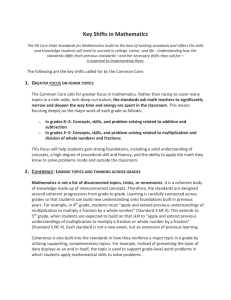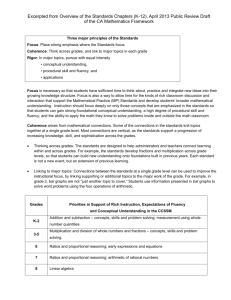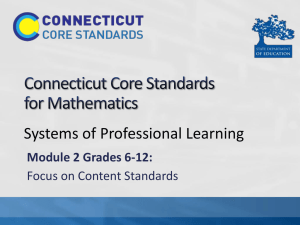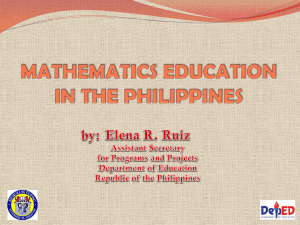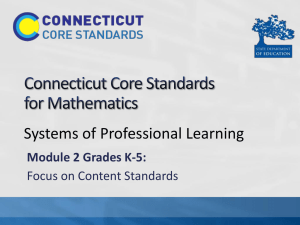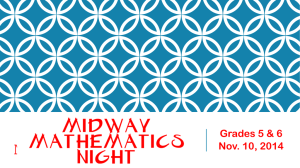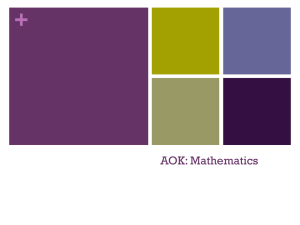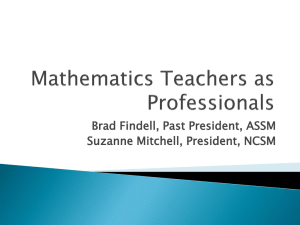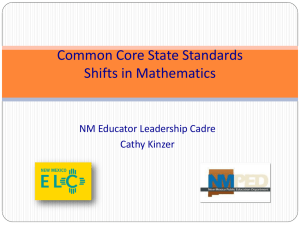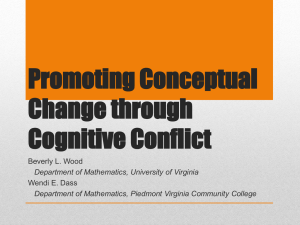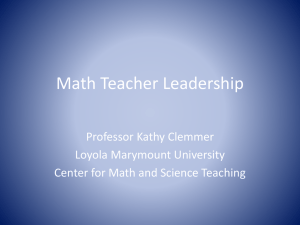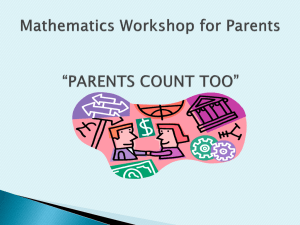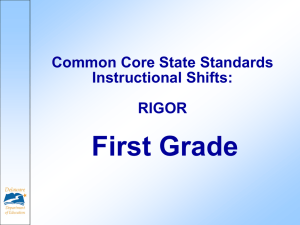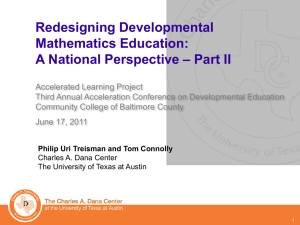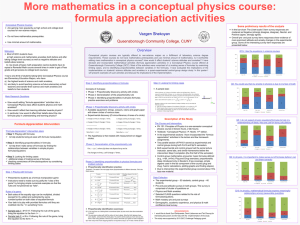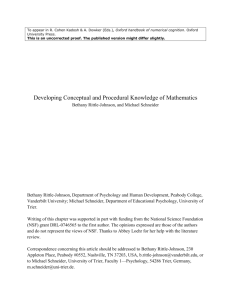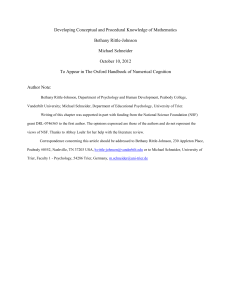Debbie Morgan - Edge Hill University
advertisement
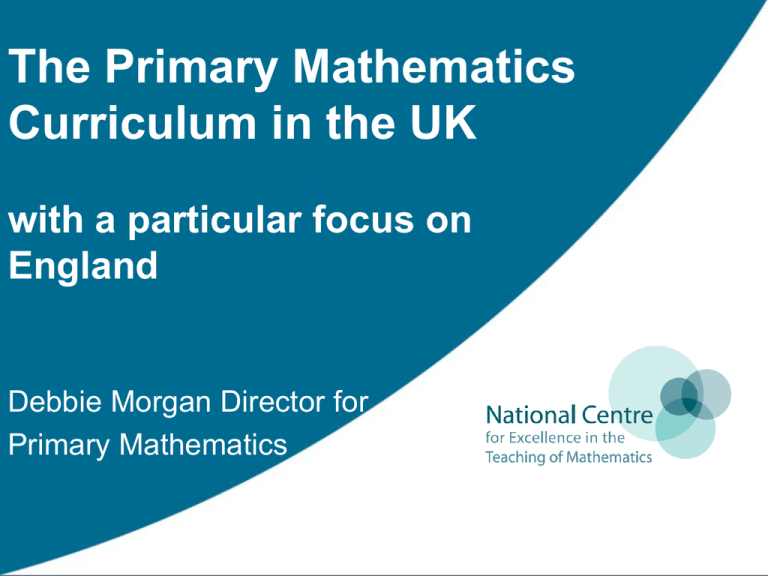
The Primary Mathematics Curriculum in the UK with a particular focus on England Debbie Morgan Director for Primary Mathematics Background • • • • • 1988 The First National Curriculum 1999 National Numeracy Strategy 2000 Revised National Curriculum 2006 Primary Strategy 2014 New National Curriculum 2 TIMSS HIGHER performance compared with England Participants performing at a significantly higher level than in England SIMILAR performance compared with England Participants performing at a similar level to England (not statistically different) LOWER performance compared with England Participants performing at a significantly lower level than England 6 countries [and 1 benchmarking participant], with their scale scores 6 other countries [and 1 benchmarking participant], with their scale scores 37 countries [and 5 benchmarking participants] including… With their scale scores Singapore Korea Hong Kong Chinese Taipei Japan Northern Ireland [North Carolina, US] Belgium (Flemish) Finland [Florida, US] ENGLAND Russian Federation United States Netherlands Denmark [Quebec, Canada] Portugal Germany Ireland, Rep of [Ontario, Canada] Australia Austria Italy [Alberta, Canada] Sweden Kazakhstan Norway New Zealand Spain 606 605 602 591 585 562 [554] 549 545 [545] 542 542 541 540 537 533 532 528 527 [518] 516 508 508 [507] 504 501 495 486 482 Table 1.1 TIMSS 2011 performance groups: mathematics at ages 9-10 Source: Exhibit 1.3 international mathematics report 3 Key Reports Good practice in primary mathematics: evidence from 20 successful schools (Ofsted November 2011) Review of the National Curriculum in England What can we learn from the English, mathematics and science curricula of high- performing jurisdictions? (DfE February 2012) 4 20 Successful Schools Report This report evidenced that many successful schools teach both fluency in mental and written methods of calculation, and understanding of the underlying mathematical concepts. 5 Review of the National Curriculum Report “... there is a wider consensus amongst mathematics educators that conceptual understanding, procedural and factual fluency and the ability to apply knowledge to solve problems are all important and mutually reinforce each other.......... Within this there is also broad consensus that automatic retrieval of basic facts facilitates the solving of more complex problems.” (DfE RR178, 2011) 6 The Aims of The New Curriculum in England The national curriculum for mathematics aims to ensure that all pupils: • become fluent in the fundamentals of mathematics, including through varied and frequent practice with increasingly complex problems over time, so that pupils develop conceptual understanding and are able to recall and apply their knowledge rapidly and accurately • reason mathematically by following a line of enquiry, conjecturing relationships and generalisations, and developing an argument, justification or proof using mathematical language • can solve problems by applying their mathematics to a variety of routine and non-routine problems with increasing sophistication, including breaking down problems into a series of simpler steps and persevering in seeking solutions. 7 The 3 Aims of the New Curriculum in England • Fluency • Reasoning • Problem Solving 8 Research: the conceptual / procedural debate Whereas past research and theory have focused predominantly on determining whether procedural or conceptual knowledge develops first (Byrnes & Wasik, 1991; Rittle-Johnson & Siegler, 1998; Siegler, 1991; Sophian, 1997), the acknowledgement that mathematical competence requires both knowing what to do and why has directed the focus of more recent research onto exploring the integration, and relations between, procedural and conceptual knowledge within mathematics learning and instruction. Voutsina 2011 9 The Interrelationship between Procedures and Concepts Research examining the interrelationship between understanding and computational skill (that is, between knowledge of concepts, and knowledge of facts and procedures in mathematics learning) has indicated that both conceptual knowledge and procedural proficiency are fundamentally linked with children’s mathematical achievement and ability to apply mathematics flexibly in different contexts (e.g. Baroody, 2003;Gray & Tall, 1994; Rittle-Johnson & Siegler, 1998 cited in Voutsina 2011). 10 Factual &Procedural Fluency Conceptual Understanding INTEGRATION 11 The Knowledge Led Curriculum 3 Forms of Knowledge Factual – I know that Procedural – I know how Conceptual – I know why 12 Is there evidence of conceptual understanding? Is there procedural fluency and efficiency? 13 Sally knows all her tables up to 12 x 12 When asked what is 12 x 13 – she looks blank Does she have knowledge of facts, underpinned by conceptual understanding ? 14 Lets do some Maths How would you solve these? + 17 = 15 + 24 99 – = 90 – 59 15 Other Principles underpinning the New Curriculum • Close the gap and raise attainment • Providing access to mathematical concepts for all children • Pupils should make connections in mathematics • Use representations to support learning • Deep rather than superficial learning • Calculating with confidence • More and longer time on fewer topics 16 Raising Expectations 17 Provision of support and resources This new curriculum unlike the introduction of the Numeracy Strategy (1999) has much less resources accompanying it, either in the form of training or documentation. However the NCETM are providing some support 18 NCETM 19 References DfE (2012) Review of the National Curriculum in England What can we learn from the English, mathematics and Science curricula of high- performing jurisdictions? Ofsted (2011) Good practice in primary mathematics: evidence from 20 successful schools Voutsina, C (2011) Procedural and Conceptual changes in young children’s problem solving Published online: Springer Science & Business Media B.V. 20
